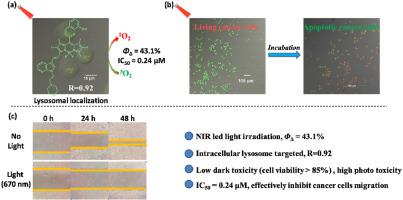Dyes and Pigments ( IF 4.1 ) Pub Date : 2020-06-04 , DOI: 10.1016/j.dyepig.2020.108615 Jin Bai , Ying Qian

|
In this work, a unique lysosome-targeted BODIPY photosensitizer named BOP-Lyso was designed for photodynamic therapy of cancer cells. The absorption wavelength of BOP-Lyso (10 μM) was located at 650 nm and its molar absorption coefficient was 8.2 × 104 cm−1M−1. The emission wavelength of BOP-Lyso was at 709 nm. Photosensitizer BOP-Lyso showed excellent ability to produce singlet oxygen and the singlet oxygen yield of photosensitizer BOP-Lyso was calculated to be 43.1% using methylene blue as the reference with near-infrared led light irradiation (660 nm). From MTT (a common method for determining cell survival rate, MTT: 3-(4, 5-dimethyl-2-thiazolyl)-2, 5-diphenyl-2-H-tetrazolium bromide) assay, BOP-Lyso had extremely low dark toxicity (cell viability > 85%) and high photo toxicity. And the IC50 value of BOP-Lyso was 0.24 μM, which was much lower than the previously reported literature. Besides that, DCFH-DA (2′,7′-Dichlorodihydrofluorescein diacetate) was employed to capture the generation of reactive oxygen species (ROS) in PDT process. Lysosomal colocalization experiments demonstrated that photosensitizer BOP-Lyso had good co-localization capability and the colocalization coefficient was calculated to be 0.92. Furthermore, photosensitizer BOP-Lyso had also been successfully applied to AO/EB cell staining experiments and exhibited excellent results. Moreover, cancer cells (SGC-7901 cells, human gastric carcinoma cells) migration status could be effectively inhibited after NIR led light irradiation with BOP-Lyso. On the whole, taking the above series of data into account, photosensitizer BOP-Lyso would play an important role in actual PDT of cancer cells.
中文翻译:

NIR和溶酶体靶向喹啉-BODIPY光敏剂的构建及其在人胃癌细胞光动力学治疗中的应用
在这项工作中,设计了一种名为BOP-Lyso的独特的靶向溶酶体的BODIPY光敏剂,用于癌细胞的光动力治疗。BOP-Lyso的吸收波长(10μM)位于650 nm,其摩尔吸收系数为8.2×10 4 cm -1 M -1。BOP-Lyso的发射波长为709nm。光敏剂BOP-Lyso表现出优异的产生单线态氧的能力,使用亚甲基蓝作为参比,在近红外led光照射下(660 nm),光敏剂BOP-Lyso的单线态氧收率经计算为43.1%。通过MTT(一种确定细胞存活率的常用方法,MTT:3-(4,5-二甲基-2-噻唑基)-2,5-二苯基-2-H-四唑溴化物)测定,BOP-Lyso的暗度极低毒性(细胞活力> 85%)和高光毒性。和IC 50BOP-Lyso的值为0.24μM,远低于先前报道的文献。除此之外,DCFH-DA(2',7'-二氯二氢荧光素二乙酸酯)被用来捕获PDT过程中活性氧(ROS)的产生。溶酶体共定位实验表明,光敏剂BOP-Lyso具有良好的共定位能力,计算的共定位系数为0.92。此外,光敏剂BOP-Lyso也已成功应用于AO / EB细胞染色实验,并显示出优异的效果。此外,在NIR引导下用BOP-Lyso照射后,可以有效抑制癌细胞(SGC-7901细胞,人胃癌细胞)的迁移状态。总体而言,考虑到上述一系列数据,











































 京公网安备 11010802027423号
京公网安备 11010802027423号